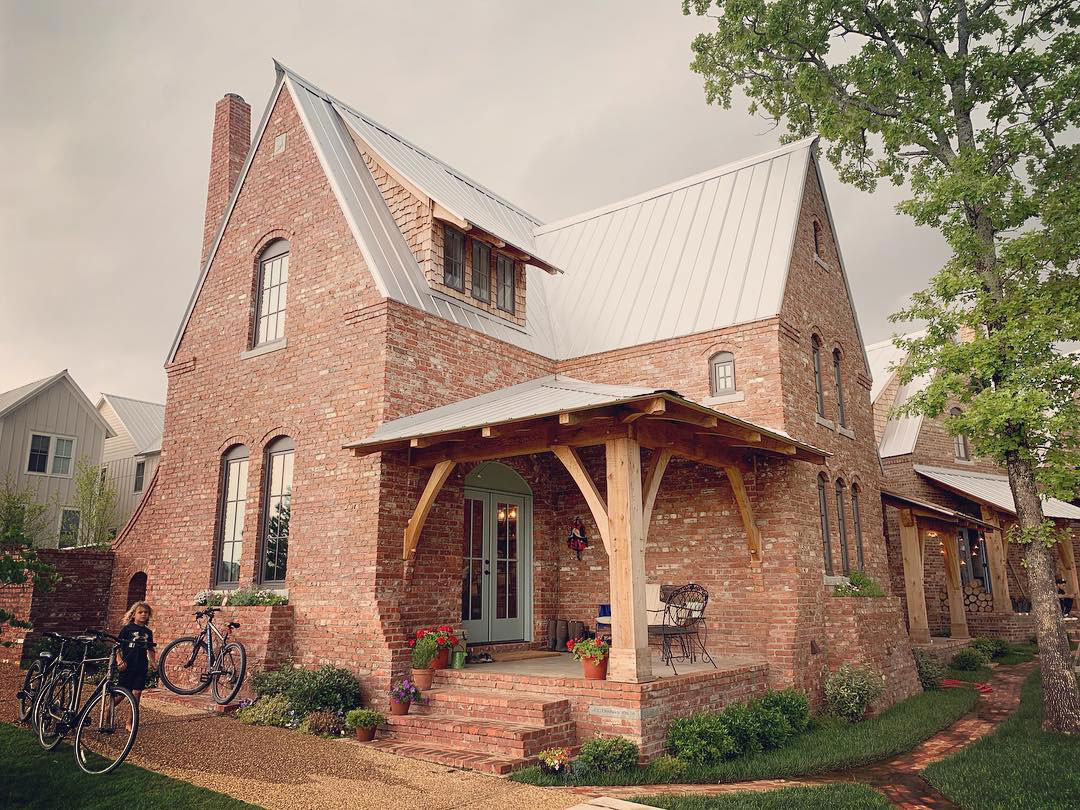
 4
4




John Daley Bendigo, Australia The Enemy of progress is the hope of a perfect plan
Benefits of rainfall collection https://permies.com/t/88043/benefits-rainfall-collection
GOOD DEBT/ BAD DEBT https://permies.com/t/179218/mortgages-good-debt-bad-debt
 3
3




Jay Angler wrote:
Not counting the porches, that house is 660 sq feet - that might not be described as a "tiny" house, but it's definitely in "small house" territory. The problem is that today, many places won't allow people to build that small, so they are forced to go "tiny on wheels" which limits them to 8-10 ft in width, which is very inefficient for design and heating.
 5
5




 4
4




This is exactly what some "tiny house communities" are doing - particularly ones geared towards an identified group. I believe somewhere in Canada, they're building one specifically for veterans for example, and I know there's at least one near Portland, Oregon specifically for transitioning homeless people. The Oregon one has all jointly used cooking facilities, washroom facilities, and a large common area with some computer access and project areas. My understanding is they have one full-time staff member whose first job is to facilitate communication skills! Most of us North Americans haven't experienced that sort of community sharing and interacting - we can't expect it to "just work" without some input in the social skills area.Conclusion: Give up on stand alone "affordable" housing. Build affordable neighborhoods instead.
Visit Redhawk's soil series: https://permies.com/wiki/redhawk-soil
How permies.com works: https://permies.com/wiki/34193/permies-works-links-threads




John Daley Bendigo, Australia The Enemy of progress is the hope of a perfect plan
Benefits of rainfall collection https://permies.com/t/88043/benefits-rainfall-collection
GOOD DEBT/ BAD DEBT https://permies.com/t/179218/mortgages-good-debt-bad-debt
 4
4




Raymond Olsen wrote:
Conclusion: Give up on stand alone "affordable" housing. Build affordable neighborhoods instead. Save resources by sharing activity spaces and services. Keep travel distances to a human scale instead of automobile scale. Mix it up so that when someone changes their lifestyle, thus changing housing needs, they may be able to continue living in the same neighborhood, in a different house. Reduce, reuse, recycle, on a human neighborhood scale.

 8
8




John C Daley wrote:Permits cost money because that is an income stream for the local council.
I think its reasonable to have then charged to new work, otherwise where will the local authority get funds to operate?
Tradition is not the worship of ashes, but the preservation of fire.
 5
5




Finished 2 life quests (well... almost). Wondering what to do next? Zone 5b
 7
7










 1
1




Tradition is not the worship of ashes, but the preservation of fire.




JayGee
 4
4




Ellendra Nauriel wrote:
some things could be made more efficient that aren't actually "problems", but they are daily annoyances. Most dirty laundry is produced in the bedrooms and bathrooms, right? So why is the laundry room often so far away from both?
 3
3




 3
3




 1
1




 2
2




 5
5




pax amor et lepos in iocando
 5
5




Iterations are fine, we don't have to be perfect
My 2nd Location:Florida HardinessZone:10 AHS:10 GDD:8500 Rainfall:2in/mth winter, 8in/mth summer, Soil:Sand pH8 Flat
 6
6




 4
4




itsmesrd




 1
1




itsmesrd
 2
2








Not just the north. In my region, dampness is the big problem.Daniel Schneider wrote:The problem with workshops in separate buildings, at least in the north, is heating.
Visit Redhawk's soil series: https://permies.com/wiki/redhawk-soil
How permies.com works: https://permies.com/wiki/34193/permies-works-links-threads




charlotte anthony wrote:i am wanting to reply to this thread and not just to this post. thank you all for some great things to consider. i am right now working in the city of eugene on a property where we will build both temporary and permament housing. a great idea you might be interested in where homeless folk help build their own temporary sturcture, participate in other ways to earn money which will be created on site, as well as be involved in building a permanent structure. i am interested in very inexpensive specific ways of permanent construction. are there other treads on permies that have ways of building, meaning the actual building materials that would work for nonskilled labor.
many thanks.
 5
5




Visit Redhawk's soil series: https://permies.com/wiki/redhawk-soil
How permies.com works: https://permies.com/wiki/34193/permies-works-links-threads
 3
3




 3
3












Actually Kim, I'd like it if you removed the word "Devil" and simply said that you wish to advocate for yourself and others who wish to live independently, because that's the best way to keep disabled people an active, participating part of society and there are many people who support that!Kim Huse wrote:However, what if the only available housing is on the second, third or 4th floor? What happens then to that disabled person who can not climb stairs? or even a ramp?
Yeah, I know I am playing Devil's advocate; but I myself am disabled, and I know a few others here are as well...and we have the right to live independently if we wish, with proper accommodations.
Four-story buildings bordering each block, enclosing a private park, then punctuated by a few public parks in some blocks. This model is proven and has served well for centuries.
Visit Redhawk's soil series: https://permies.com/wiki/redhawk-soil
How permies.com works: https://permies.com/wiki/34193/permies-works-links-threads
 3
3




Kim Huse wrote:However, what if the only available housing is on the second, third or 4th floor? What happens then to that disabled person who can not climb stairs? or even a ramp?






 2
2




Tradition is not the worship of ashes, but the preservation of fire.




Abraham Palma wrote:
Take this with a grain of salt: I suspect that people that usually take the stairs have less probability of having mobility issues just because they keep exercising.
Become extra-civilized!
 1
1




I think what is particularly impressive about Fuggerei is that the buildings are still housing people after nearly 500 years. Current housing built in my region is considered "old" and "ripe to tear down and start again at 60 to 80 years of age, and it wasn't cheap to begin with.Jeremy VanGelder wrote:Have I posted about the Fuggerei yet? I think the buildings are made of rammed earth.
Visit Redhawk's soil series: https://permies.com/wiki/redhawk-soil
How permies.com works: https://permies.com/wiki/34193/permies-works-links-threads




John Daley Bendigo, Australia The Enemy of progress is the hope of a perfect plan
Benefits of rainfall collection https://permies.com/t/88043/benefits-rainfall-collection
GOOD DEBT/ BAD DEBT https://permies.com/t/179218/mortgages-good-debt-bad-debt






 3
3




John C Daley wrote:Has anything progressed on this issue?
 . He says the foundation and walls cost $50,000. They are made to be nice houses in an affluent neighborhood. It proves that structural brick can be approved in America for reasonable prices.
. He says the foundation and walls cost $50,000. They are made to be nice houses in an affluent neighborhood. It proves that structural brick can be approved in America for reasonable prices.Tradition is not the worship of ashes, but the preservation of fire.

|
Willie Smits increased rainfall 25% in three years by planting trees. Tiny ad:
The new gardening playing cards kickstarter is now live!
https://www.kickstarter.com/projects/paulwheaton/garden-cards
|







